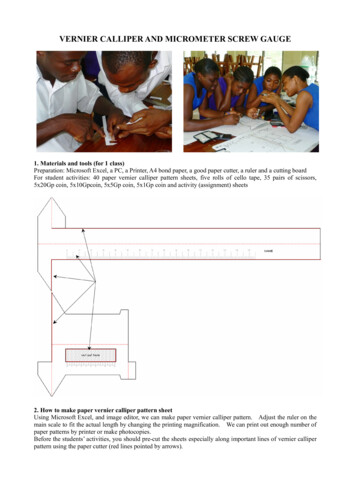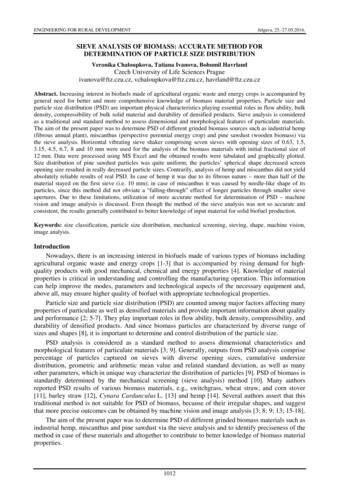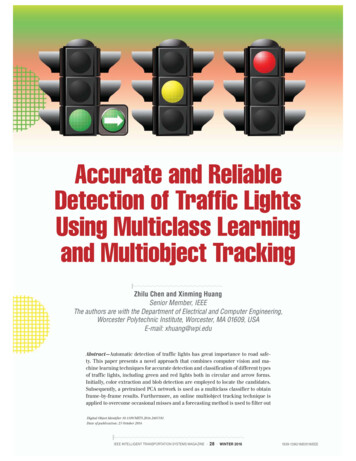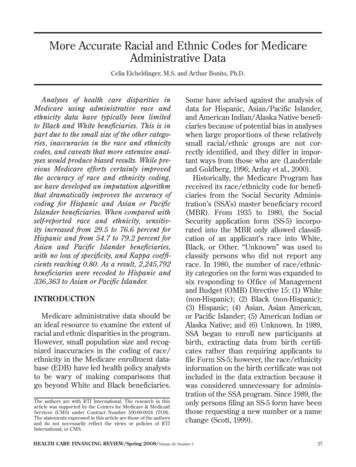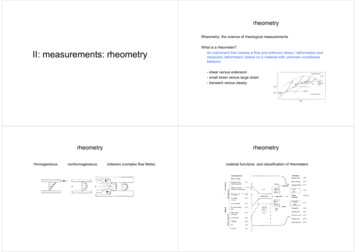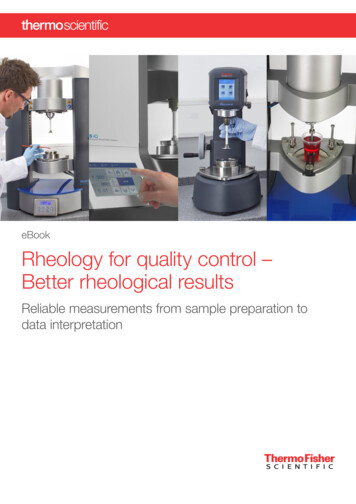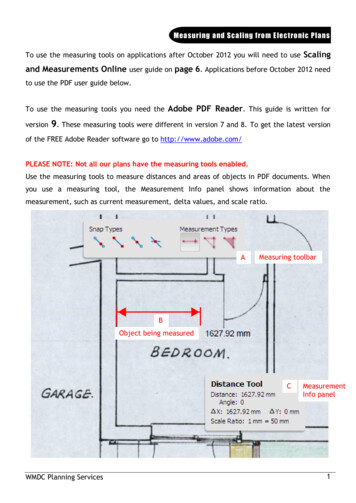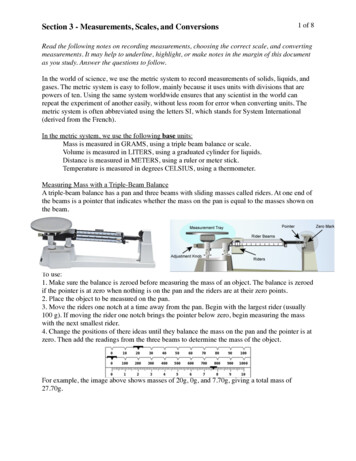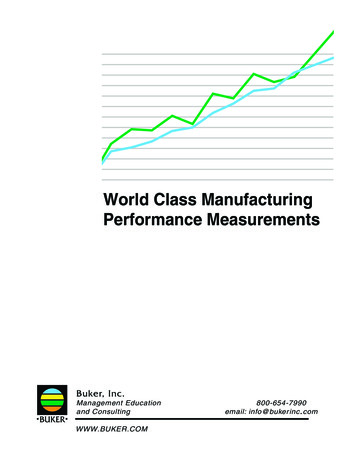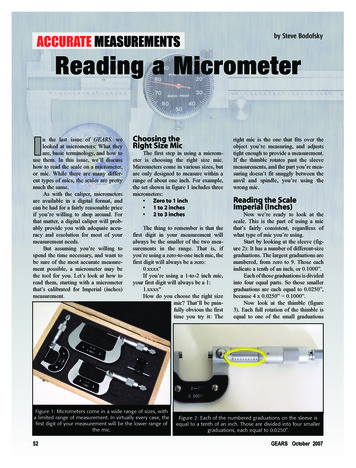
Transcription
ACCURATE MEASUREMENTSby Steve BodofskyReading a MicrometerIn the last issue of GEARS, welooked at micrometers: What theyare, basic terminology, and how touse them. In this issue, we’ll discusshow to read the scale on a micrometer,or mic. While there are many different types of mics, the scales are prettymuch the same.As with the caliper, micrometersare available in a digital format, andcan be had for a fairly reasonable priceif you’re willing to shop around. Forthat matter, a digital caliper will probably provide you with adequate accuracy and resolution for most of yourmeasurement needs.But assuming you’re willing tospend the time necessary, and want tobe sure of the most accurate measurement possible, a micrometer may bethe tool for you. Let’s look at how toread them, starting with a micrometerthat’s calibrated for Imperial (inches)measurement.Choosing theRight Size MicThe first step in using a micrometer is choosing the right size mic.Micrometers come in various sizes, butare only designed to measure within arange of about one inch. For example,the set shown in figure 1 includes threemicrometers: Zero to 1 inch 1 to 2 inches 2 to 3 inchesThe thing to remember is that thefirst digit in your measurement willalways be the smaller of the two measurements in the range. That is, ifyou’re using a zero-to-one inch mic, thefirst digit will always be a zero:0.xxxx"If you’re using a 1-to-2 inch mic,your first digit will always be a 1:1.xxxx"How do you choose the right sizemic? That’ll be painfully obvious the firsttime you try it: TheFigure 1: Micrometers come in a wide range of sizes, witha limited range of measurement. In virtually every case, thefirst digit of your measurement will be the lower range ofthe mic.52right mic is the one that fits over theobject you’re measuring, and adjuststight enough to provide a measurement.If the thimble rotates past the sleevemeasurements, and the part you’re measuring doesn’t fit snuggly between theanvil and spindle, you’re using thewrong mic.Reading the ScaleImperial (Inches)Now we’re ready to look at thescale. This is the part of using a micthat’s fairly consistent, regardless ofwhat type of mic you’re using.Start by looking at the sleeve (figure 2): It has a number of different-sizegraduations. The largest graduations arenumbered, from zero to 9. Those eachindicate a tenth of an inch, or 0.1000”.Each of those graduations is dividedinto four equal parts. So those smallergraduations are each equal to 0.0250”,because 4 x 0.0250” 0.1000”.Now look at the thimble (figure3). Each full rotation of the thimble isequal to one of the small graduationsFigure 2: Each of the numbered graduations on the sleeve isequal to a tenth of an inch. Those are divided into four smallergraduations, each equal to 0.0250”.GEARS October 2007
Parts for Automatic TransmissionsSEE YOU INLAS VEGAS!Please call for an appointment with us:Phones: 49 171 3307071 or 49 151 e.de
Reading a Micrometeron the sleeve, or 0.0250”. The thimble is divided into different sized graduations, too. The longest graduations arenumbered by fives; each of them is equal to 0.0050”.Those graduations are divided again; how many timesdepends on the resolution of your micrometer. In this case,the larger graduations are each equal to 0.0010”; the smaller equal 0.0005”, or five ten-thousandths of an inch.That’s pretty good, but it’s not the limit of our resolution. Take another look at the sleeve. See those extra divisions, running perpendicular to the first set we discussed(figure 4)? That’s called the vernier scale; each graduationon the vernier scale is equal to 0.0001”. So this micrometercan provide measurements that resolve down to one tenthousandth of an inch! The trick to reading the micrometeris to add the readings on each scale, to provide a single,complete measurement of the object.TIP:Not all micrometers have a vernier scale; in fact,not all mics have a scale that reads down below 0.001”(figure 5). In that case, all you can do is estimate the tenthousandths measurement, based on the position of thethimble in relation to the spindle.Figure 3: A full rotation of the thimble equals one graduationon the sleeve. And the thimble is divided into smaller graduations; in this case, down to 0.0005”.Measuring with a MicImperial (Inches)Now let’s see how to read the micrometer scales tomeasure an object. For this measurement, I’ve chosen asmall adjustable wrench. To make the measurement (figure6): Zero the micrometer. Open the micrometer enough to allow the item tofit between the anvil and spindle. Close the micrometer against the area you wantto measure, using the ratchet to adjust it against the objectwithout overtightening it. Lock the micrometer spindle using the locknut.If you’re unsure of any of these procedures, readthe Accurate Measurements article in the last issue ofGEARS.Now we’re ready to read the measurement. To makeit easier to read and explain, I’ve decided to cheat just abit: I’m using a flattened drawing of the micrometer scale,adjusted exactly the way the micrometer displayed itsmeasurement (figure 7). This just makes it easier for youto read the display all at once, without having to rotate themicrometer to see all the different scales. Think of it likeFigure 4: The vernier scale allows you to refine your measurement even further; down to just 0.0001”.Figure 5: Not all mics have a vernier scale. If yours doesn’t,you can estimate the difference between the zero line and thegraduations on the thimble. Figure 6: The procedure for measuring an object withan outside mic is always pretty much the same. If you’reunsure of the procedures, read the Accurate Measurementcolumn in the last issue of GEARS.54 Figure 7: This is a flattened version of a micrometer scale; likeusing a world map instead of a globe. The advantage is it letsyou examine all of the scales at once, without having to rotatethe mic to see the rest of the scale — a big benefit in print!GEARS October 2007
)NSIDE EVERY 4RANS4EC KIT YOU LL ALWAYS lND THE HIGHEST QUALITY COMPONENTS THEMOST COMPLETE TECHNICAL INFORMATION AND LOGICAL SUB PACKAGING .OBODY MAKESTRANSMISSION PARTS MORE DEPENDABLE "ETTER PARTS AND BETTER PERFORMANCEMEANS LESS CHANCE OF A COMEBACK SO INSIST ON REBUILDING WITH THE BEST )NSIST ON 4RANS4EC KITS FROM &REUDENBERG ./ THE / % SUPPLIER WITHAFTERMARKET VISION 4 s & s WWW 4RANS4EC COM s -ILAN /( )F )T #OMES "ACK AD REV INDD 0-
Reading a Micrometerusing a map of the world instead of a globe; everything’sright there in front of you, instead of rotating it to seewhat’s on the back.Since the micrometer we used was a zero-to-1 inchmic, the first digit will be a zero:0.xxxx” Next we look at the large, numbered graduations onthe sleeve. The thimble is back far enough to reveal thethird numbered graduation, so the measurement is at leastthree tenths of an inch. Here’s what we have so far:0.3xxx”A closer look at the sleeve reveals at least one smallergraduation is showing; maybe two. So which is it, one ortwo? It’s one; here’s how we know:Look at the graduations on the thimble (figure 8).Notice we’re close to the 20; that is, we’re near the end ofits scale. Remember, each rotation of the thimble is equal toone small graduation on the sleeve. So, since we’re near theend of the scale on the thimble, we’re just short of the second graduation on the sleeve. That’s why we can see a littleof the next graduation, even though we haven’t reached thesecond graduation yet.Okay, so we have one small graduation showing on thesleeve; that’s another 0.0250”:0.3000” 0.0250”0.3250” Figure 8: Are we seeing one graduation or two past the 3 onthe sleeve? It has to be one, because we’re too close to thehigh end of the scale on the thimble. Next, look at the graduations on the thimble (figure 9).The zero indicator line on the sleeve is lined up just a bitshy of 21. 21 would be 0.0210”; since this is less, it’d be0.0200”. But there’s another, short graduation, between the20 and 21. That’s 0.0005”, so the thimble reads 0.0205”.That’s how much we add to the formula:0.3000”0.0250” 0.0205”0.3455” Figure 9: The graduations on the thimble tell you how muchto add to your initial measurement. In this case, you’ll beadding 0.0205”. But wait; there’s more! Notice that the zero indicator isjust a tiny bit past the 0.0005” mark. This is where the vernier scale comes in. Look at the vernier scale, and find thegraduation that lines up with a graduation on the thimble(figure 10). In this case, it’s the 3. That’s another 0.0003”to add to the total. So our final measurement is:0.3000”0.0250”0.0205” 0.0003”0.3458”And that’s the final measurement in inches: 0.3458”.Reading a Metric MicSome of you aren’t forced to fight with measuringlength in inches, feet, yards and miles. Some of you get towork in simple decimal equivalents, known as the Metric56 Figure 10: To refine your measurement even further, see whichgraduation on the vernier scale lines up with a graduation on thethimble. Then add that number to the 1/10,000ths column.GEARS October 2007
New SuperFlow TransDyno SF-66KThe convenience, reliability, versatility and ability to test virtuallyevery transmission on the road, including the new Allison models.Handles hydraulically and electrically shifted transmissions, foreignand domestic, in FWD, RWD and AWD configurations. Monitorsand tests virtually every aspect of transmission performance, undersimulated road load conditions, before the transmission is installed supported by the accuracy and superior documentation of theexclusive TDAC (Transmission Data Acquisition & Control) System.SuperShifterThe NEW DurableIn-Car TesterRugged design, solidstate electronics,impact-resistant housing.Tests most late model transmissions. Controlsthe transmission from inside the car. Tests Solenoidcurrent/resistance. Operator ID and Date/Time stamp.Embedded Bluetooth for external device connectivity.Shown withmanual console.Valve Body TestersPrecision test valve bodies,solenoids and pressuretransducers with actualtransmission pressures andheated oil under toughestsimulated driving conditions.Solenoid TestersA must for testing theweakest link six ata time. Easy to use.TCRS Torque Converter Test and Rebuild SystemsExcellent profit center for transmission repair shops or stand-alone startups and smartest way to save time and prevent costly comebacks.Single Gun Auto Weld AlignerStandard of the industry.And choice of the big three— Ford, GM, Daimler-Chrysler.Air-operated collets. Patentedauto-tack and auto-weld.Do “bowl buildups” andweld on impeller hubs.TAC 12 control panel letsyou automatically controlnumber of tacs and duration.New! Improved!Torque ConverterBalancernow with automaticweight indexing,runout compensation mode, pushbuttom polishingand better accuracyand repeatabilitythan ever before.Check out convertersBEFORE you ship orinstall with HUB RUNOUTINSPECTION UNITS. And,ensure your converterquality (after welding)with AIR TEST STANDSfor diagnosing leaks.Hicklin Heavy-DutyTransmission Dynamometersfor trucks, mass transit, military, off-highway. In-line v-drive angle drive Allison,Renk, ZF, Voith and many others. Also askabout towing, axle and brake dynamometersfor medium- to heavy-duty trucks; andtorque converter dynamometers for testingunder real-world, full-load conditions.SuperFlow Dynos and FlowbenchesRecognized world leader in flowbench technology, plus awide range of engine dynos, chassis dynos and software.Helps OEMs, high performance test engineers and enginebuilders take performance to the next level.www.superflow.comsuperflow ad.indd 318354 Gears TestCenterAd Dec2006.1 1When youreally needto know 4060 Dixon Street Des Moines IA 50313 ph: 888-442-5546 or 515-254-1654 fax: 515-254-165612/26/06 11:38:48 AM12/13/06 4:27:02 PM
Reading a Micrometersystem. For you, there are specially designed micrometers,calibrated in millimeters.One of the first things you might notice about thisMetric micrometer is that it doesn’t have a vernier scale(figure 11). It only measures down to hundredths of a millimeter. Why aren’t Metric micrometers calibrated to resolveas well as an Imperial micrometer?Actually, there isn’t much difference between thetwo. Remember, millimeters are a lot smaller than inches:It takes 25.4 of them to equal just one inch. A hundredthof a millimeter equals just under 0.0004”. So the Metricmicrometer provides almost the same resolution as theImperial one, even without a vernier scale. And you canstill approximate more precisely, simply by paying attention to how close the graduations are to the zero line.NOTE: While there may be some Metric mics with avernier scale, I couldn’t find one. I presume it’s because ofthe inherent resolution in the Metric mics, eliminating theneed for it. If anyone has a Metric mic with a vernier scale,I’d be happy to use it to add a section to the upcomingbooklet for the ATRA web site.The next thing to notice is the scale on the sleeve(figure 12). There are two sets of graduations: one abovethe zero line and a second below it. The set above the lineis the measurement in millimeters: Each graduation equalsone millimeter. The set below the line is calibrated in halfmillimeters, or 0.5 mm.And the scale on the thimble is divided into 50 graduations. Each rotation moves the thimble a half millimeter, soeach graduation on the thimble equals 0.01 mm.Let’s use the Metric micrometer to measure the samewrench, and see how close the two measurements are.We’ll use the same technique to measure the wrench asbefore, and then read the scale.The sleeve shows 8 graduations above the zero line, soit’s more than 8 mm, but less than 9 mm (figure 13). Andthere’s one additional graduation showing below the line,so that’s another half millimeter. So far, the wrench
That’s called the vernier scale; each graduation on the vernier scale is equal to 0.0001”. So this micrometer can provide measurements that resolve down to one ten-thousandth of an inch! The trick to reading the micrometer is to add the readings on each scale, to provide a single, complete measurement of the object. TIP:Not all micrometers have a vernier scale; in fact, not all mics have a .
